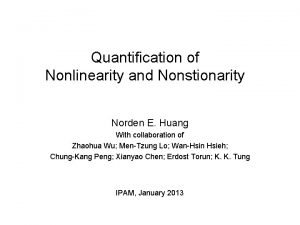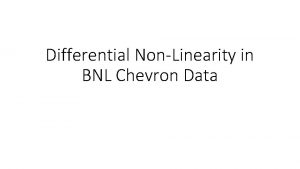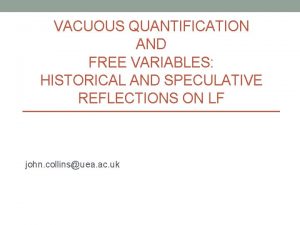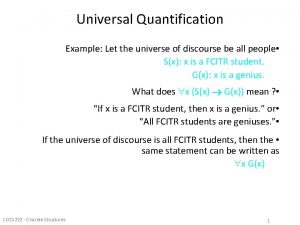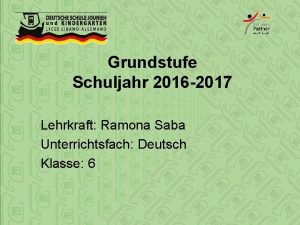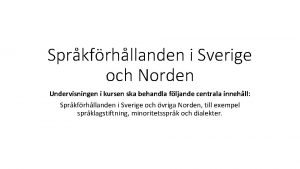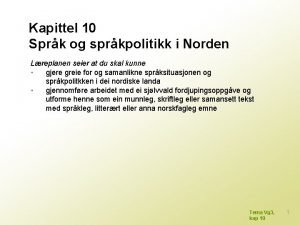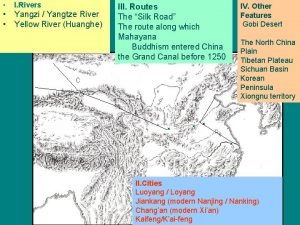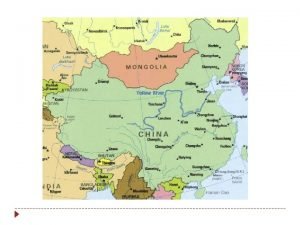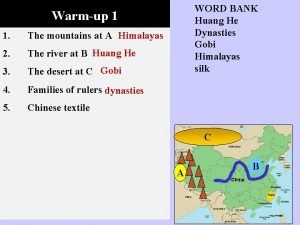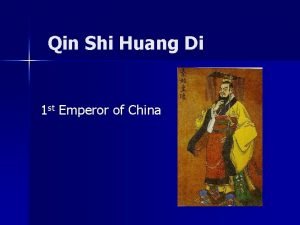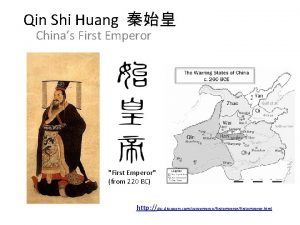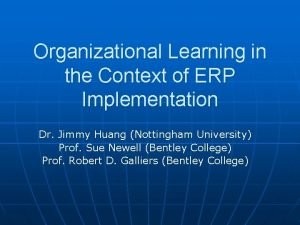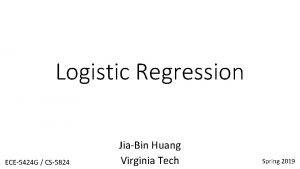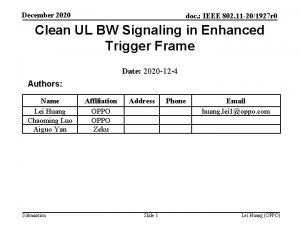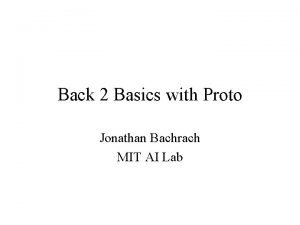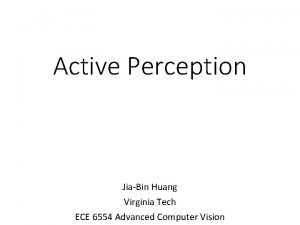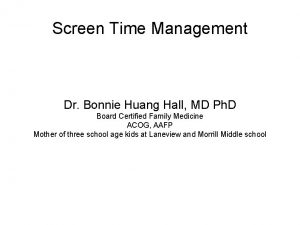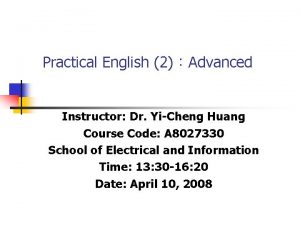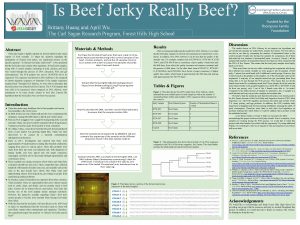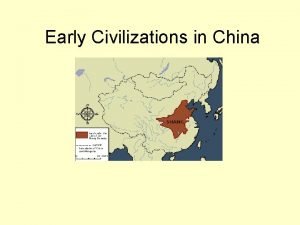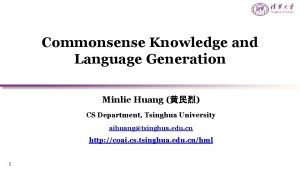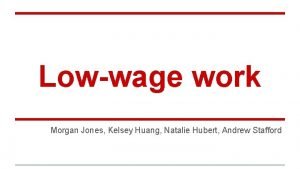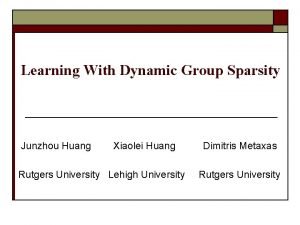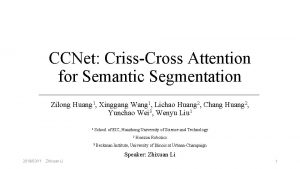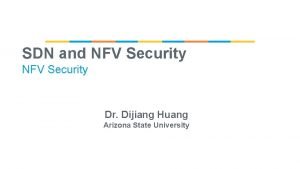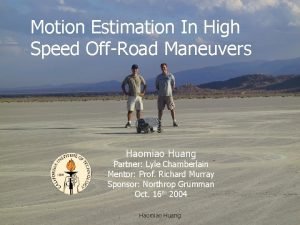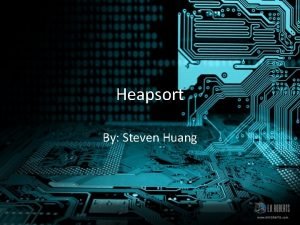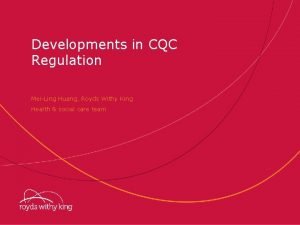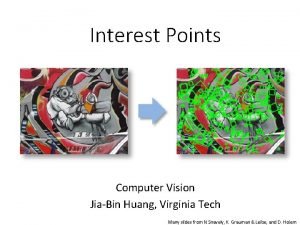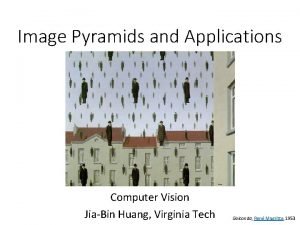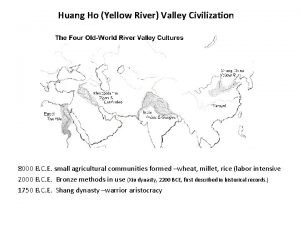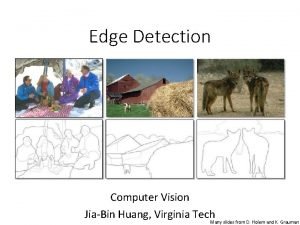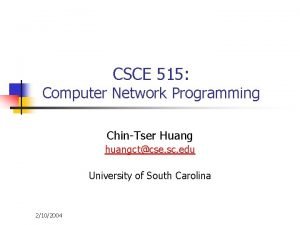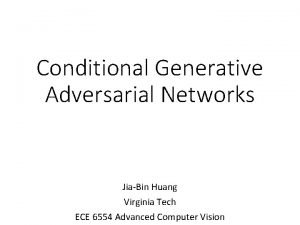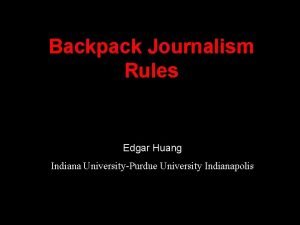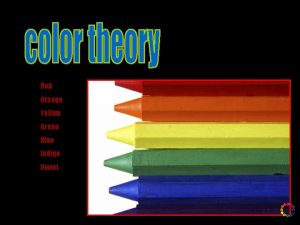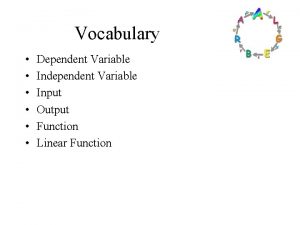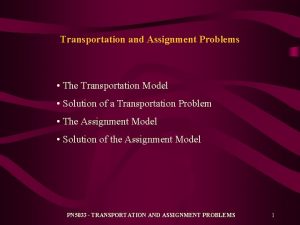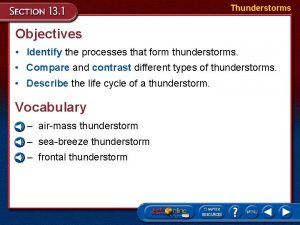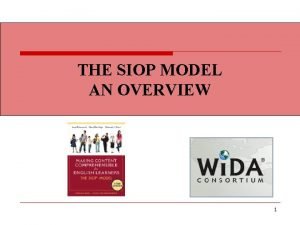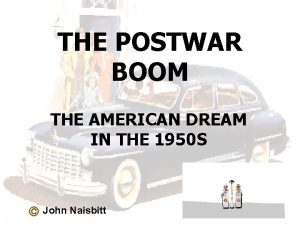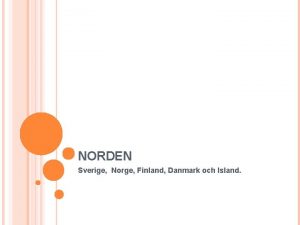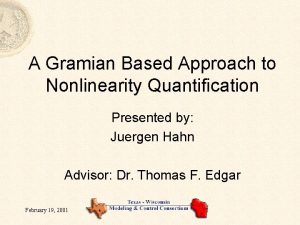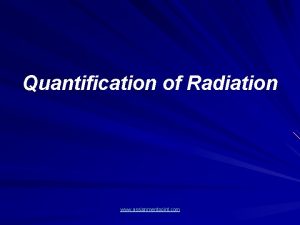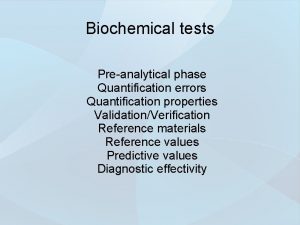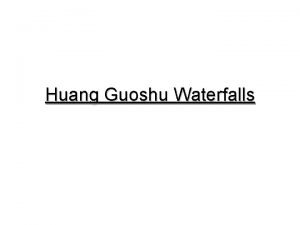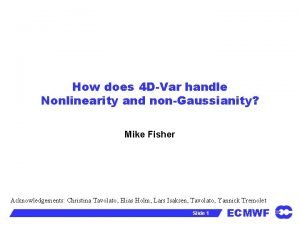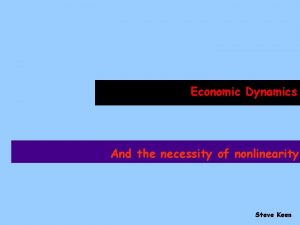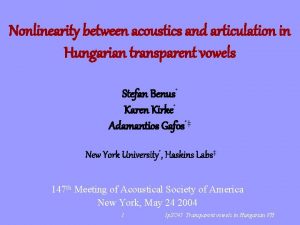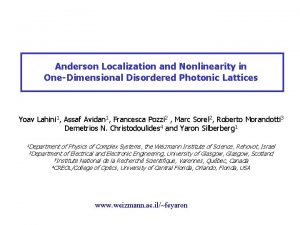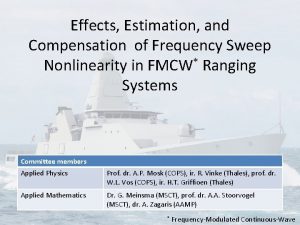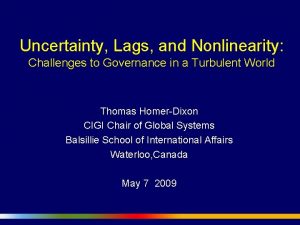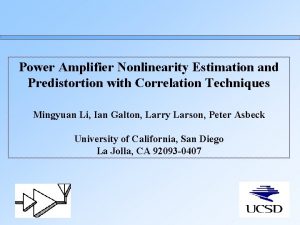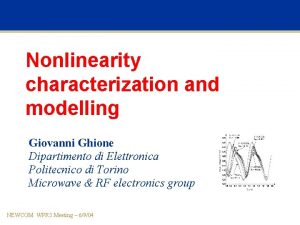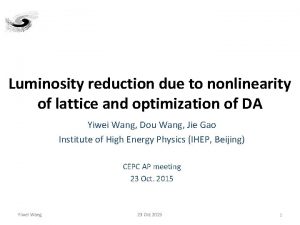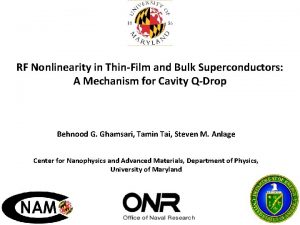Quantification of Nonlinearity and Nonstionarity Norden E Huang
























































































- Slides: 88

Quantification of Nonlinearity and Nonstionarity Norden E. Huang With collaboration of Zhaohua Wu; Men-Tzung Lo; Wan-Hsin Hsieh; Chung-Kang Peng; Xianyao Chen; Erdost Torun; K. K. Tung IPAM, January 2013


The term, ‘Nonlinearity, ’ has been loosely used, most of the time, simply as a fig leaf to cover our ignorance. Can we measure it?

How is nonlinearity defined? Based on Linear Algebra: nonlinearity is defined based on input vs. output. But in reality, such an approach is not practical: natural system are not clearly defined; inputs and out puts are hard to ascertain and quantify. Nonlinear system is not always so compliant: in the autonomous systems the results could depend on initial conditions rather than the magnitude of the ‘inputs. ’ There might not be that forthcoming small perturbation parameter to guide us. Furthermore, the small parameter criteria could be totally wrong: small parameter is more nonlinear.

Linear Systems Linear systems satisfy the properties of superposition and scaling. Given two valid inputs as well as their respective outputs then a linear system must satisfy for any scalar values α and β.

How is nonlinearity defined? Based on Linear Algebra: nonlinearity is defined based on input vs. output. But in reality, such an approach is not practical: natural system are not clearly defined; inputs and out puts are hard to ascertain and quantify. Nonlinear system is not always so compliant: in the autonomous systems the results could depend on initial conditions rather than the magnitude of the ‘inputs. ’ There might not be that forthcoming small perturbation parameter to guide us. Furthermore, the small parameter criteria could be totally wrong: small parameter is more nonlinear.

Nonlinearity Tests • Based on input and outputs and probability distribution: qualitative and incomplete (Bendat, 1990) • Higher order spectral analysis, same as probability distribution: qualitative and incomplete • Nonparametric and parametric: Based on hypothesis that the data from linear processes should have near linear residue from a properly defined linear model (ARMA, …), or based on specific model: Qualitative

How should nonlinearity be defined? The alternative is to define nonlinearity based on data characteristics: Intra-wave frequency modulation is the deviation of the instantaneous frequency from the mean frequency (based on the zero crossing period).

Characteristics of Data from Nonlinear Processes

Nonlinear Pendulum : Asymmetric

Nonlinear Pendulum : Symmetric

Duffing Equation : Data

Hilbert’s View on Nonlinear Data

A simple mathematical model

Duffing Type Wave Data: x = cos(wt+0. 3 sin 2 wt)

Duffing Type Wave Perturbation Expansion

Duffing Type Wavelet Spectrum

Duffing Type Wave Hilbert Spectrum

Duffing Type Wave Marginal Spectra

The advantages of using HHT • In Fourier representation based on linear and stationary assumptions; intra-wave modulations result in harmonic distortions with phase locked non-physical harmonics residing in the higher frequency ranges, where noise usually dominates. • In HHT representation based on instantaneous frequency; intra-wave modulations result in the broadening of fundamental frequency peak, where signal strength is the strongest.

Define the degree of nonlinearity Based on HHT for intra-wave frequency modulation

Characteristics of Data from Nonlinear Processes

Degree of nonlinearity

The influence of amplitude variations Single component To consider the local amplitude variations, the definition of DN should also include the amplitude information; therefore the definition for a single component should be:

The influence of amplitude variations for signals with multiple components To consider the case of signals with multiple components, we should assign weight to each individual component according to a normalized scheme:

Degree of Nonlinearity • We can determine DN precisely with Hilbert Spectral Analysis. • We can also determine δ and η separately. • η can be determined from the instantaneous frequency modulations relative to the mean frequency. • δ can be determined from DN with η determined. NB: from any IMF, the value of ηδ cannot be greater than 1. • The combination of δ and η gives us not only the Degree of Nonlinearity, but also some indications of the basic properties of the controlling Differential Equation.

Calibration of the Degree of Nonlinearity Using various Nonlinear systems

Stokes Models

Stokes I

Phase Diagram

IMFs

Data and IFs : C 1

Data and IFs : C 2

Stokes II

Phase Diagram

Data and Ifs : C 1

Data and Ifs : C 1 details

Data and Ifs : C 2

Combined Stokes I and II

Water Waves Real Stokes waves

Comparison : Station #1

Data and IF : Station #1 DN=0. 1607

Duffing Models

Duffing I

Phase Diagram

IMFs

Data and IFs

Data and Ifs Details

Summary Duffing I

Duffing II

Summary Duffing II

Summary Duffing II

Duffing O : Original

Data and IFs

Data and Ifs : Details

Phase Diagram

IMFs

Duffing 0 : Original

Phase : e=0. 50

IMF e=0. 50

Data and Ifs : e=0. 50

Data and Ifs : details e=0. 50

Summary : Epsilon

Summary All Duffing Models

Lorenz Model

Lorenz Model • Lorenz is highly nonlinear; it is the model equation that initiated chaotic studies. • Again it has three parameters. We decided to fix two and varying only one. • There is no small perturbation parameter. • We will present the results for ρ=28, the classic chaotic case.

Phase Diagram for ro=28

X-Component DN 1=0. 5147 CDN=0. 5027

Data and IF

Spectra data and IF

IMFs

Hilbert Spectrum

Degree of Nonstationarity Quantify nonstationarity

Need to define the Degree Stationarity • Traditionally, stationarity is taken for granted; it is given; it is an article of faith. • All the definitions of stationarity are too restrictive and qualitative. • Good definition need to be quantitative to give a Degree of Stationarity

Definition : Strictly Stationary

Definition : Wide Sense Stationary

Definition : Statistically Stationary • If the stationarity definitions are satisfied with certain degree of averaging. • All averaging involves a time scale. The definition of this time scale is problematic.

Stationarity Tests • To test stationarity or quantify non-stationarity, we need a precise time-frequency analysis tool. • In the past, Wigner-Ville distribution had been used. But WV is Fourier based, which only make sense under stationary assumption. • We will use a more precise time-frequency representation based on EMD and Hilbert Spectral Analysis.

Degree of Stationarity Huang et al (1998)

Problems • The instantaneous frequency used here includes both intra-wave and inter-wave frequency modulations: mixed nonlinearity with nonstationarity. • We have to define frequency here based on whole wave period, ωz , to get only the interwave modulation. • We have also to define the degree of nonstationarity in a time dependent way.

Tim-dependent Degree of non-Stationarity: with a sliding window ΔT

Time-dependent Degree of Non-linearity For both nonstationary and nonlinear processes

Time-dependent degree of nonlinearity To consider the local frequency and amplitude variations, the definition of DN should be timedependent as well. All values are defined within a sliding window ΔT:

Application to Biomedical case

Heart Rate Variability : AF Patient


Conclusion • With HHT, we can have a precisely defined instantaneous frequency; therefore, we can also define nonlinearity quantitatively. • Nonlinearity should be a state of a system dynamically rather than statistically. • There are many applications for the degree of nonlinearity in system integrity monitoring in engineering, biomedical and natural phenomena.

Thanks
 Norden e. huang
Norden e. huang Differential nonlinearity
Differential nonlinearity Nonlinearity
Nonlinearity Vacuous quantification
Vacuous quantification Universe of discourse examples
Universe of discourse examples Highly multiplexed protein quantification
Highly multiplexed protein quantification Utredande text om språksituationen i norden
Utredande text om språksituationen i norden Bbs norden
Bbs norden Danmark posten
Danmark posten Alan norden
Alan norden Peter norden
Peter norden Jantelagen
Jantelagen Minoritetsspråk i norden
Minoritetsspråk i norden Deutschland grenzt im norden an
Deutschland grenzt im norden an I rivers
I rivers Yellow river shang
Yellow river shang Where is the huang he river
Where is the huang he river Va cooperative studies program
Va cooperative studies program Emperor qin quotes
Emperor qin quotes Qin shi huang ror
Qin shi huang ror Jimmy huang nottingham
Jimmy huang nottingham Dr meng huang
Dr meng huang Jiabin huang
Jiabin huang Dr hanxian huang
Dr hanxian huang Hwang ho river valley
Hwang ho river valley Huang zeku
Huang zeku Protopay
Protopay Cvpr
Cvpr Peninggalan sungai huang ho
Peninggalan sungai huang ho Bonnie huang hall
Bonnie huang hall Yicheng huang
Yicheng huang Brittany huang
Brittany huang Hearth of confucianism
Hearth of confucianism Huang he pronunciation
Huang he pronunciation Minlie huang
Minlie huang Zeyi huang
Zeyi huang Natalie hubert
Natalie hubert Huang xiaolei
Huang xiaolei Huang he river
Huang he river Ccnet: criss-cross attention for semantic segmentation
Ccnet: criss-cross attention for semantic segmentation Buddha bless me buddha bless you
Buddha bless me buddha bless you Huang he flodkultur
Huang he flodkultur Huang he
Huang he Jojo
Jojo Dijiang huang
Dijiang huang Imperador qin shi huang
Imperador qin shi huang Haomiao huang
Haomiao huang Mass number 80
Mass number 80 Jia-bin huang
Jia-bin huang Jiabin huang
Jiabin huang Jia-bin huang
Jia-bin huang Dr steven huang
Dr steven huang Qi huang facebook
Qi huang facebook Mei-ling huang
Mei-ling huang The huang he flows to the __________.
The huang he flows to the __________. Why did the shang rulers become powerful
Why did the shang rulers become powerful Jiabin huang
Jiabin huang Find matching pictures
Find matching pictures Huang ho valley
Huang ho valley Jiabin huang
Jiabin huang Chin-tser huang
Chin-tser huang Jiabin huang
Jiabin huang Dugen huang
Dugen huang The huang he flows to the __________.
The huang he flows to the __________. Edgar huang
Edgar huang Qi huang facebook
Qi huang facebook Red green yellow orange blue black white brown pink purple
Red green yellow orange blue black white brown pink purple Willaim blake
Willaim blake West side story, romeo and juliet comparison chart
West side story, romeo and juliet comparison chart Taller and younger and shorter and older
Taller and younger and shorter and older How to write 5 centavos
How to write 5 centavos Red orange yellow green blue purple violet
Red orange yellow green blue purple violet Your teacher is giving you a test worth 100 points
Your teacher is giving you a test worth 100 points Young and dyslexic exam question
Young and dyslexic exam question Albany movement
Albany movement West yorkshire health and care partnership
West yorkshire health and care partnership Draw and label transverse wave
Draw and label transverse wave Compare and contrast spring tides and neap tides.
Compare and contrast spring tides and neap tides. Independent variable and dependent variable
Independent variable and dependent variable Transitive and intransitive and linking verbs
Transitive and intransitive and linking verbs What is the role of life
What is the role of life Records and reports in nursing
Records and reports in nursing Transportation and assignment problems
Transportation and assignment problems Compare and contrast cold wave and wind chill factor
Compare and contrast cold wave and wind chill factor Purchases in profit and loss account
Purchases in profit and loss account Siop and tap have similar descriptors and indicators
Siop and tap have similar descriptors and indicators Tomorrow shakespeare
Tomorrow shakespeare We are ladies and gentlemen serving
We are ladies and gentlemen serving Automania definition 1950
Automania definition 1950
